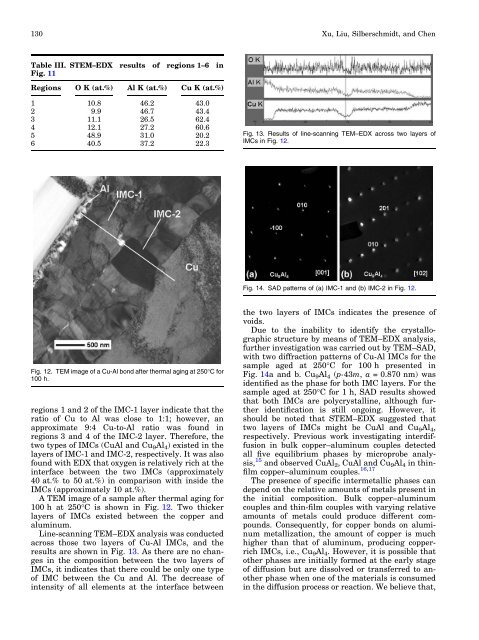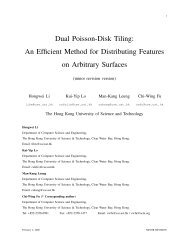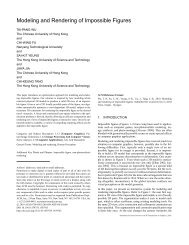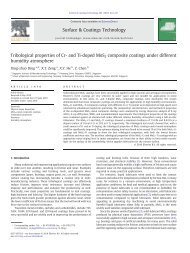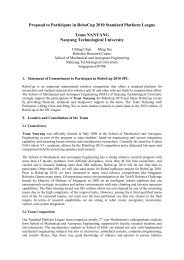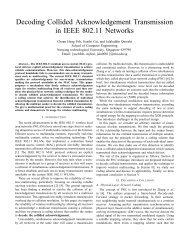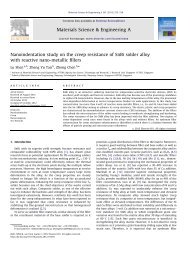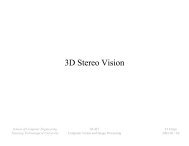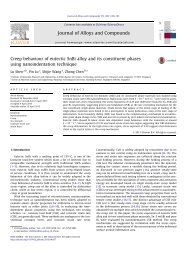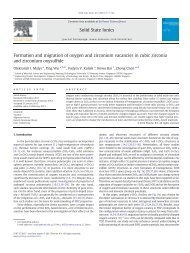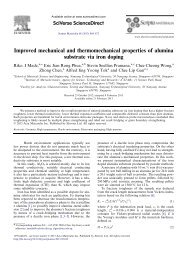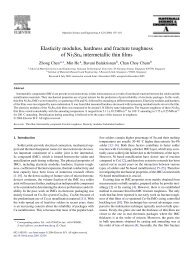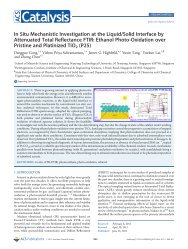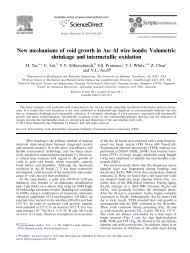Growth of Intermetallic Compounds in Thermosonic Copper Wire ...
Growth of Intermetallic Compounds in Thermosonic Copper Wire ...
Growth of Intermetallic Compounds in Thermosonic Copper Wire ...
You also want an ePaper? Increase the reach of your titles
YUMPU automatically turns print PDFs into web optimized ePapers that Google loves.
130<br />
Table III. STEM–EDX results <strong>of</strong> regions 1–6 <strong>in</strong><br />
Fig. 11<br />
Regions O K (at.%) Al K (at.%) Cu K (at.%)<br />
1 10.8 46.2 43.0<br />
2 9.9 46.7 43.4<br />
3 11.1 26.5 62.4<br />
4 12.1 27.2 60.6<br />
5 48.9 31.0 20.2<br />
6 40.5 37.2 22.3<br />
Fig. 12. TEM image <strong>of</strong> a Cu-Al bond after thermal ag<strong>in</strong>g at 250°C for<br />
100 h.<br />
regions 1 and 2 <strong>of</strong> the IMC-1 layer <strong>in</strong>dicate that the<br />
ratio <strong>of</strong> Cu to Al was close to 1:1; however, an<br />
approximate 9:4 Cu-to-Al ratio was found <strong>in</strong><br />
regions 3 and 4 <strong>of</strong> the IMC-2 layer. Therefore, the<br />
two types <strong>of</strong> IMCs (CuAl and Cu 9Al 4) existed <strong>in</strong> the<br />
layers <strong>of</strong> IMC-1 and IMC-2, respectively. It was also<br />
found with EDX that oxygen is relatively rich at the<br />
<strong>in</strong>terface between the two IMCs (approximately<br />
40 at.% to 50 at.%) <strong>in</strong> comparison with <strong>in</strong>side the<br />
IMCs (approximately 10 at.%).<br />
A TEM image <strong>of</strong> a sample after thermal ag<strong>in</strong>g for<br />
100 h at 250°C is shown <strong>in</strong> Fig. 12. Two thicker<br />
layers <strong>of</strong> IMCs existed between the copper and<br />
alum<strong>in</strong>um.<br />
L<strong>in</strong>e-scann<strong>in</strong>g TEM–EDX analysis was conducted<br />
across those two layers <strong>of</strong> Cu-Al IMCs, and the<br />
results are shown <strong>in</strong> Fig. 13. As there are no changes<br />
<strong>in</strong> the composition between the two layers <strong>of</strong><br />
IMCs, it <strong>in</strong>dicates that there could be only one type<br />
<strong>of</strong> IMC between the Cu and Al. The decrease <strong>of</strong><br />
<strong>in</strong>tensity <strong>of</strong> all elements at the <strong>in</strong>terface between<br />
Xu, Liu, Silberschmidt, and Chen<br />
Fig. 13. Results <strong>of</strong> l<strong>in</strong>e-scann<strong>in</strong>g TEM–EDX across two layers <strong>of</strong><br />
IMCs <strong>in</strong> Fig. 12.<br />
Fig. 14. SAD patterns <strong>of</strong> (a) IMC-1 and (b) IMC-2 <strong>in</strong> Fig. 12.<br />
the two layers <strong>of</strong> IMCs <strong>in</strong>dicates the presence <strong>of</strong><br />
voids.<br />
Due to the <strong>in</strong>ability to identify the crystallographic<br />
structure by means <strong>of</strong> TEM–EDX analysis,<br />
further <strong>in</strong>vestigation was carried out by TEM–SAD,<br />
with two diffraction patterns <strong>of</strong> Cu-Al IMCs for the<br />
sample aged at 250°C for 100 h presented <strong>in</strong><br />
Fig. 14a and b. Cu9Al4 (p-43m, a = 0.870 nm) was<br />
identified as the phase for both IMC layers. For the<br />
sample aged at 250°C for 1 h, SAD results showed<br />
that both IMCs are polycrystall<strong>in</strong>e, although further<br />
identification is still ongo<strong>in</strong>g. However, it<br />
should be noted that STEM–EDX suggested that<br />
two layers <strong>of</strong> IMCs might be CuAl and Cu 9Al 4,<br />
respectively. Previous work <strong>in</strong>vestigat<strong>in</strong>g <strong>in</strong>terdiffusion<br />
<strong>in</strong> bulk copper–alum<strong>in</strong>um couples detected<br />
all five equilibrium phases by microprobe analysis,<br />
15 and observed CuAl2, CuAl and Cu9Al4 <strong>in</strong> th<strong>in</strong>film<br />
copper–alum<strong>in</strong>um couples. 16,17<br />
The presence <strong>of</strong> specific <strong>in</strong>termetallic phases can<br />
depend on the relative amounts <strong>of</strong> metals present <strong>in</strong><br />
the <strong>in</strong>itial composition. Bulk copper–alum<strong>in</strong>um<br />
couples and th<strong>in</strong>-film couples with vary<strong>in</strong>g relative<br />
amounts <strong>of</strong> metals could produce different compounds.<br />
Consequently, for copper bonds on alum<strong>in</strong>um<br />
metallization, the amount <strong>of</strong> copper is much<br />
higher than that <strong>of</strong> alum<strong>in</strong>um, produc<strong>in</strong>g copperrich<br />
IMCs, i.e., Cu9Al4. However, it is possible that<br />
other phases are <strong>in</strong>itially formed at the early stage<br />
<strong>of</strong> diffusion but are dissolved or transferred to another<br />
phase when one <strong>of</strong> the materials is consumed<br />
<strong>in</strong> the diffusion process or reaction. We believe that,


